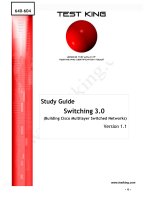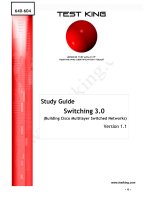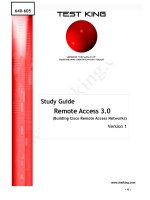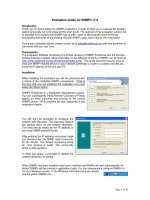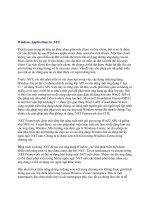Tài liệu Study Guide Switching 3.0 (Building Cisco Multilayer Switched Networks) Version 1.1 pptx
Bạn đang xem bản rút gọn của tài liệu. Xem và tải ngay bản đầy đủ của tài liệu tại đây (861.8 KB, 121 trang )
640-604 Switching 3.0
www.testking.com
- 1 -
640-604
Study Guide
Switching 3.0
(Building Cisco Multilayer Switched Networks)
Version 1.1
640-604 Switching 3.0
www.testking.com
- 2 -
TABLE OF CONTENTS
List of Tables
List of Acronyms
Introduction
1. The Campus Network
1.1 The Traditional Campus Network
1.1.1 Collisions
1.1.2 Bandwidth
1.1.3 Broadcasts and Multicasts
1.2 The New Campus Network
1.3 The 80/20 Rule and the New 20/80 Rule
1.4 Switching Technologies
1.4.1 Open Systems Interconnection Model
1.4.1.1 Data Encapsulation
1.4.1.2 Layer 2 Switching
1.4.1.3 Layer 3 Switching
1.4.1.4 Layer 4 Switching
1.4.1.5 Multi-Layer Switching (MLS)
1.4.2 The Cisco Hierarchical Model
1.4.2.1 Core Layer
1.4.2.2 Distribution Layer
1.4.2.3 Access Layer
1.5 Modular Network Design
1.5.1 The Switch Block
1.5.2 The Core Block
1.5.2.1 Collapsed Core
1.5.2.2 Dual Core
1.5.2.3 Core Size
1.5.2.4 Core Scalability
1.5.2.5 Layer 3 Core
2. Basic Switch and Port Configuration
2.1 Network Technologies
2.1.1 Ethernet
2.1.1.1 Ethernet Switches
2.1.1.2 Ethernet Media
640-604 Switching 3.0
www.testking.com
- 3 -
2.1.2 Fast Ethernet
2.1.3 Gigabit Ethernet
2.1.4 10Gigabit Ethernet
2.1.5 Token Ring
2.2 Connecting Switches
2.2.1 Console Port Cables and Connectors
2.2.2 Ethernet Port Cables and Connectors
2.2.3 Gigabit Ethernet Port Cables and Connectors
2.2.4 Token Ring Port Cables and Connectors
2.3 Switch Management
2.3.1 Switch Naming
2.3.2 Password Protection
2.3.3 Remote Access
2.3.4 Inter-Switch Communication
2.3.5 Switch Clustering and Stacking
2.4 Switch Port Configuration
2.4.1 Port Description
2.4.2 Port Speed
2.4.3 Ethernet Port Mode
2.4.4 Token Ring Port Mode
3. Virtual LANs (VLANs) and Trunking
3.1 VLAN Membership
3.2 Extent of VLANs
3.3 VLAN Trunks
3.3.1 VLAN Frame Identification
3.3.2 Dynamic Trunking Protocol
3.3.3 VLAN Trunk Configuration
3.4 VLAN Trunking Protocol (VTP)
3.4.1 VTP Modes
3.4.1.1 Server Mode
3.4.1.2 Client Mode
3.4.1.3 Transparent Mode
3.4.2 VTP Advertisements
3.4.2.1 Summary Advertisements
3.4.2.2 Subset Advertisements
3.4.2.3 Client Request Advertisements
3.4.3 VTP Configuration
3.4.3.1 Configuring a VTP Management Domain
3.4.3.2 Configuring the VTP Mode
3.4.3.3 Configuring the VTP Version
640-604 Switching 3.0
www.testking.com
- 4 -
3.4.4 VTP Pruning
3.5 Token Ring VLANs
3.5.1 TrBRF
3.5.2 TrCRF
3.5.3 VTP and Token Ring VLANs
3.5.4 Duplicate Ring Protocol (DRiP)
4. Redundant Switch Links
4.1 Switch Port Aggregation with EtherChannel
4.1.1 Bundling Ports with EtherChannel
4.1.2 Distributing Traffic in EtherChannel
4.1.3 Port Aggregation Protocol (PAgP)
4.1.4 EtherChannel Configuration
4.2 Spanning-Tree Protocol (STP
4.3 Spanning-Tree Communication
4.3.1 Root Bridge Election
4.3.2 Root Ports Election
4.3.3 Designated Ports Election
4.4 STP States
4.5 STP Timers
4.6 Convergence
4.6.1 PortFast: Access Layer Nodes
4.6.2 UplinkFast: Access Layer Uplinks
4.6.3 BackboneFast: Redundant Backbone Paths
4.7 Spanning-Tree Design
4.8 STP Types
4.8.1 Common Spanning Tree (CST)
4.8.2 Per-VLAN Spanning Tree (PVST)
4.8.3 Per-VLAN Spanning Tree Plus (PVST+)
5. Trunking with ATM LAN Emulation (LANE)
5.1 ATM
5.1.1 The ATM Model
5.1.2 Virtual Circuits
5.1.3 ATM Addressing
5.1.3.1 VPI/VCI Addresses
5.1.3.2 NSAP Addresses
5.1.4 ATM Protocols
640-604 Switching 3.0
www.testking.com
- 5 -
5.2 LAN Emulation (LANE)
5.2.1 LANE Components
5.2.2 LANE Operation
5.2.3 Address Resolution
5.2.4 LANE Component Placement
5.2.5 LANE Component Redundancy (SSRP)
5.3 LANE Configuration
5.3.1 Configuring the LES and BUS
5.3.2 Configuring the LECS
5.3.3 Configuring Each LEC
5.3.4 Viewing the LANE Configuration
6. InterVLAN Routing
6.1 InterVLAN Routing Design
6.1.1 Routing with Multiple Physical Links
6.1.2 Routing over Trunk Links
6.1.2.1 802.1Q and ISL Trunks
6.1.2.2 ATM LANE
6.2 Routing with an Integrated Router
6.3 InterVLAN Routing Configuration
6.3.1 Accessing the Route Processor
6.3.2 Establishing VLAN Connectivity
6.3.2.1 Establishing VLAN Connectivity with Physical
Interfaces
6.3.2.2 Establishing VLAN Connectivity with Trunk Links
6.3.2.3 Establishing VLAN Connectivity with LANE
6.3.2.4 Establishing VLAN Connectivity with Integrated
Routing Processors
6.3.3 Configure Routing Processes
6.3.4 Additional InterVLAN Routing Configurations
7. Multilayer Switching (MLS)
7.1 Multilayer Switching Components
7.2 MLS-RP Advertisements
7.3 Configuring Multilayer Switching
7.4 Flow Masks
7.5 Configuring the MLS-SE
7.5.1 MLS Caching
640-604 Switching 3.0
www.testking.com
- 6 -
7.5.2 Verifying MLS Configurations
7.5.3 External Router Support
7.5.4 Switch Inclusion Lists
7.5.5 Displaying MLS Cache Entries
8. Cisco Express Forwarding (CEF)
8.1 CEF Components
8.1.1 Forwarding Information Base (FIB)
8.1.2 Adjacency Tables
8.2 CEF Operation Modes
8.3 Configuring Cisco Express Forwarding
8.3.1 Configuring Load Balancing for CEF
8.3.1.1 Per-Destination Load Balancing
8.3.1.2 Per-Packet Load Balancing
8.3.2 Configuring Network Accounting for CEF
9. The Hot Standby Router Protocol (HSRP)
9.1 Traditional Redundancy Methods
9.1.1 Default Gateways
9.1.2 Proxy ARP
9.1.3 Routing Information Protocol (RIP)
9.1.4 ICMP Router Discovery Protocol (IRDP)
9.2 Hot Standby Router Protocol
9.2.1 HSRP Group Members
9.2.2 Addressing HSRP Groups Across ISL Links
9.3 HSRP Operations
9.3.1 The Active Router
9.3.2 Locating the Virtual Router MAC Address
9.3.3 Standby Router Behavior
9.3.4 HSRP Messages
9.3.5 HSRP States
9.4 Configuring HSRP
9.4.1 Configuring an HSRP Standby Interface
9.4.2 Configuring HSRP Standby Priority
9.4.3 Configuring HSRP Standby Preempt
9.4.4 Configuring the Hello Message Timers
9.4.5 HSRP Interface Tracking
9.4.6 Configuring HSRP Tracking
9.4.7 HSRP Status
9.5 Troubleshooting HSRP
640-604 Switching 3.0
www.testking.com
- 7 -
10. Multicasts
10.1 Unicast Traffic
10.2 Broadcast Traffic
10.3 Multicast Traffic
10.4 Multicast Addressing
10.4.1 Multicast Address Structure
10.4.2 Mapping IP Multicast Addresses to Ethernet
10.4.3 Managing Multicast Traffic
10.4.4 Subscribing and Maintaining Groups
10.4.4.1 IGMP Version 1
10.4.4.2 IGMP Version 2
10.4.5 Switching Multicast Traffic
10.5 Routing Multicast Traffic
10.5.1 Distribution Trees
10.5.2 Multicast Routing Protocols
10.5.2.1 Dense Mode Routing Protocols
10.5.2.2 Sparse Mode Routing Protocols
10.6 Configuring IP Multicast
10.6.1 Enabling IP Multicast Routing
10.6.2 Enabling PIM on an Interface
10.6.2.1 Enabling PIM in Dense Mode
10.6.2.2 Enabling PIM in Sparse Mode
10.6.2.3 Enabling PIM in Sparse-Dense Mode
10.6.2.4 Selecting a Designated Router
10.6.3 Configuring a Rendezvous Point
10.6.4 Configuring Time-To-Live
10.6.5 Debugging Multicast
10.6.6 Configuring Internet Group Management Protocol (IGMP)
10.6.7 Configuring Cisco Group Management Protocol (CGMP)
11. Controlling Access in the Campus Environment
11.1 Access Policies
11.2 Managing Network Devices
11.2.1 Physical Access
11.2.2 Passwords
11.2.3 Privilege Levels
11.2.4 Virtual Terminal Access
11.3 Access Layer Policy
640-604 Switching 3.0
www.testking.com
- 8 -
11.4 Distribution Layer Policy
11.4.1 Filtering Traffic at the Distribution Layer
11.4.2 Controlling Routing Update Traffic
11.4.3 Configuring Route Filtering
11.5 Core Layer Policy
12. Monitoring and Troubleshooting
12.1 Monitoring Cisco Switches
12.1.1 Out-of-Band Management
12.1.1.1 Console Port Connection
12.1.1.2 Serial Line Internet Protocol (SLIP)
12.1.2 In-Band Management
12.1.2.1 SNMP
12.1.2.2 Telnet Client Access
12.1.2.3 Cisco Discovery Protocol (CDP)
12.1.3 Embedded Remote Monitoring
12.1.4 Switched Port Analyzer
12.1.5 CiscoWorks 2000
12.2 General Troubleshooting Model
12.2.1 Troubleshooting with show Commands
12.2.2 Physical Layer Troubleshooting
12.2.3 Troubleshooting Ethernet
12.2.3.1 Network Testing
12.2.3.2 The Traceroute Command
12.2.3.3 Network Media Test Equipment
640-604 Switching 3.0
www.testking.com
- 9 -
LIST OF TABLES
TABLE 1.1:
TABLE 2.1:
TABLE 2.2:
TABLE 2.3:
TABLE 2.4:
TABLE 5.1:
TABLE 7.1:
TABLE 8.1:
TABLE 10.1:
TABLE 11.1:
TABLE 12.1:
TABLE 12.2:
TABLE 12.3:
TABLE 12.4:
TABLE 12.5:
OSI Encapsulation
Coaxial Cable for Ethernet
Twisted-Pair and Fiber Optic Cable for Ethernet
Fast Ethernet Cabling and Distance Limitations
Gigabit Ethernet Cabling and Distance Limitations
Automatic NSAP Address Generation for LANE Components
Displaying Specific MLS Cache Entries
Adjacency Types for Exception Processing
Well-Known Class D Addresses
Access Policy Guidelines
Keywords and Arguments for the set snmp trap Command
CiscoWorks 2000 LAN Management Features
Ethernet Media Problems
Parameters for the ping Command
Parameters for the traceroute Command
640-604 Switching 3.0
www.testking.com
- 10 -
LIST OF ACRONYMS
AAA
ABR
ACF
ACK
ACL
ACS
AD
ADSL
ANSI
API
APPC
ARAP
ARE
ARP
ARPA
ARPANET
AS
ASA
ASBR
ASCII
ASIC
ATM
AUI
Authentication, Authorization, and Accounting
Area Border Router
Advanced Communications Function
Acknowledgment bit (in a TCP segment)
Access Control List
Access Control Server
Advertised Distance
Asymmetric Digital Subscriber Line
American National Standards Institute
Application Programming Interface
Advanced Program-to-Program Communications
AppleTalk Remote Access Protocol
All Routes Explorer
Address Resolution Protocol
Advanced Research Projects Agency
Advanced Research Projects Agency Network
Autonomous System
Adaptive Security Algorithm
Autonomous System Boundary Router
American Standard Code for Information Interchange
Application Specific Integrated Circuits
Asynchronous Transfer Mode
Attachment Unit Interface
Bc
B channel
BDR
Be
BECN
BGP
BGP-4
BIA
Committed burst (Frame Relay)
Bearer channel ( ISDN)
Backup Designated Router
Excess burst (Frame Relay)
Backward Explicit Congestion Notification (Frame Relay)
Border Gateway Protocol
BGP version 4
Burned-in Address (another name for a MAC address)
640-604 Switching 3.0
www.testking.com
- 11 -
BOD
BPDU
BRF
BRI
BSD
Bandwidth on Demand.
Bridge Protocol Data Unit
Bridge Relay Function
Basic Rate Interface (ISDN)
Berkeley Standard Distribution (UNIX)
CBT
CBWFQ
CCITT
CCO
CDDI
CEF
CHAP
CIDR
CIR
CGMP
CLI
CLSC
CPE
CPU
CR
CRC
CRF
CST
CSU
Core Based Trees
Class-Based Weighted Fair Queuing
Consultative Committee for International Telegraph and Telephone
Cisco Connection Online
Copper Distribution Data Interface
Cisco Express Forwarding
Challenge Handshake Authentication Protocol
Classless Interdomain Routing
Committed Information Rate. (Frame Relay)
Cisco Group Management Protocol
Command-Line Interface
Cisco LAN Switching Configuration
Customer Premises Equipment
Central Processing Unit
Carriage Return.
Cyclic Redundancy Check (error)
Concentrator Relay Function
Common Spanning Tree
Channel Service Unit
DB
DCE
dCEF
DDR
DE
DECnet
DES
DHCP
DLCI
DNIC
Data Bus (connector)
Data Circuit-Terminating Equipment
Distributed CEF
Dial-on-Demand Routing
Discard Eligible Indicator
Digital Equipment Corporation Protocols
Data Encryption Standard
Dynamic Host Control Protocol
Data-Link Connection Identifier
Data Network Identification Code. (X.121addressing)
640-604 Switching 3.0
www.testking.com
- 12 -
DNS
DoD
DR
DRiP
DS
DS0
DS1
DS3
DSL
DSU
DTE
DTP
DUAL
DVMRP
Domain Name System
Department of Defense (US)
Designated Router
Duplicate Ring Protocol
Digital Signal
Digital Signal level 0
Digital Signal level 1
Digital Signal level 3
Digital Subscriber Line
Data Service Unit
Data Terminal Equipment
Dynamic Trunking Protocol
Diffusing Update Algorithm
Distance Vector Multicast Routing Protocol
EBC
EGP
EIA/TIA
EIGRP
ESI
Ethernet Bundling Controller
Exterior Gateway Protocol
Electronic Industries Association/Telecommunications Industry Association
Enhanced IGRP
End-System Identifier
FCC
FCS
FC
FD
FDDI
FEC
FECN
FIB
FIFO
FR
FS
FSSRP
FTP
Federal Communications Commission
Frame Check Sequence
Feasible Condition (Routing)
Feasible Distance (Routing)
Fiber Distributed Data Interface
Fast EtherChannel
Forward Explicit Congestion Notification
Forwarding Information Base
First-In, First-Out (Queuing)
Frame Relay
Feasible Successor (Routing)
Fast Simple Server Redundancy Protocol
File Transfer Protocol
GBIC
GEC
Gigabit Interface Converters
Gigabit EtherChannel
640-604 Switching 3.0
www.testking.com
- 13 -
GSR Gigabit Switch Router
HDLC
HDSL
HSRP
HSSI
HTTP
High-Level Data Link Control
High data-rate digital subscriber line
Hot Standby Router Protocol
High-Speed Serial Interface
Hypertext Transfer Protocol
I/O
IANA
ICMP
IDN
IEEE
IETF
IGP
IGRP
ILMI
IOS
IP
IPSec
IPv6
IPX
IRDP
IS
IS-IS
ISDN
ISL
ISO
ISOC
ISP
ITU-T
Input/Output
Internet Assigned Numbers Authority
Internet Control Message Protocol
International Data Number
Institute of Electrical and Electronic Engineers
Internet Engineering Task Force
Interior Gateway Protocol
Interior Gateway Routing Protocol
Integrated Local Management Interface
Internetwork Operating System
Internet Protocol
IP Security
IP version 6
Internetwork Packet Exchange (Novell)
ICMP Router Discovery Protocol
Information Systems
Intermediate System-to-Intermediate System
Integrated Services Digital Network
Inter-Switch Link
International Organization for Standardization
Internet Society
Internet Service Provider
International Telecommunication Union–Telecommunication Standardization Sector
kbps kilobits per second (bandwidth)
LAN
LANE
LAPB
LAPD
Local Area Network
LAN Emulation
Link Access Procedure, Balanced
Link Access Procedure on the D channel
640-604 Switching 3.0
www.testking.com
- 14 -
LEC
LECS
LED
LES
LLC
LLQ
LMI
LSA
LAN Emulation Client
LAN Emulation Configuration Server
Light Emitting Diode
LAN Emulation Server
Logic Link Control (OSI Layer 2 sublayer)
Low-Latency Queuing
Local Management Interface
Link-State Advertisement
MAC
MAN
MD5
MLS
MLS-RP
MLS-SE
MLSP
MOSPF
MSAU
MSFC
MTU
Media Access Control (OSI Layer 2 sublayer)
Metropolitan-Area Network
Message Digest Algorithm 5
Multilayer Switching
Multilayer Switching Route Processor
Multilayer Switching Switch Engine
Multilayer Switching Protocol
Multicast Open Shortest Path First
Multistation Access Unit
Multilayer Switch Feature Card
Maximum Transmission Unit
NAK
NAS
NAT
NBMA
NetBEUI
NetBIOS
NFFC
NMS
NNI
NSAP
NVRAM
Negative Acknowledgment
Network Access Server
Network Address Translation
Nonbroadcast Multiaccess
NetBIOS Extended User Interface
Network Basic Input/Output System
NetFlow Feature Card
Network Management System
Network-to-Network Interface
Network Service Access Point
Nonvolatile Random Access Memory
OC
ODBC
OLE
OSI
Optical Carrier
Open Database Connectivity
Object Linking and Embedding
Open Systems Interconnection (Model)
640-604 Switching 3.0
www.testking.com
- 15 -
OSPF
OTDR
OUI
Open Shortest Path First
Optical Time Domain Reflectometer
Organizationally Unique Identifier
PAgP
PAP
PAT
PDN
PDU
PIM
PIM
PIMDM
PIX
PNNI
POP
POTS
PPP
PQ
PRI
PSTN
PTT
PVC
PVST
PVST+
Port Aggregation Protocol
Password Authentication Protocol
Port Address Translation
Public Data Network
Protocol Data Unit (i.e., a data packet)
Protocol Independent Multicast
SM Protocol Independent Multicast Sparse Mode
Protocol Independent Multicast Mode
Private Internet Exchange (Cisco Firewall)
Private Network-to-Network Interface
Point of Presence
Plain Old Telephone Service
Point-to-Point Protocol
Priority Queuing
Primary Rate Interface (ISDN)
Public Switched Telephone Network
Poste, Telephone, Telegramme
Permanent Virtual Circuit (ATM)
Per-VLAN Spanning Tree
Per-VLAN Spanning Tree Plus
QoS Quality of Service
RADIUS
RAS
RIF
RIP
RJ
RMON
RP
RPF
RSFC
RSM
Remote Authentication Dial-In User Service
Remote Access Service
Routing Information Field
Routing Information Protocol
Registered Jack (connector)
Embedded Remote Monitoring
Rendezvous Point
Reverse Path Forwarding
Route Switch Feature Card
Route Switch Module
640-604 Switching 3.0
www.testking.com
- 16 -
RSP
RTP
RTO
Route Switch Processor
Reliable Transport Protocol
Retransmission Timeout
SA
SAID
SAP
SAPI
SAR
SDLC
SIA
SIN
SLIP
SMDS
SMTP
SNA
SNAP
SNMP
SOF
SOHO
SONET
SONET/SDH
SPAN
SPF
SPID
SPP
SPX
SQL
SRAM
SRB
SRT
SRTT
SS7
SSAP
SSE
Source Address
Security Association Identifier
Service Access Point; also Service Advertising Protocol (Novell)
Service Access Point Identifier
Segmentation and Reassembly
Synchronous Data Link Control (SNA)
Stuck in Active (EIGRP)
Ships-in-the-Night (Routing)
Serial Line Internet Protocol
Switched Multimegabit Data Service
Simple Mail Transfer Protocol
Systems Network Architecture (IBM)
SubNetwork Access Protocol
Simple Network Management Protocol
Start of Frame
Small Office, Home Office
Synchronous Optical Network
Synchronous Optical Network/Synchronous Digital Hierarchy
Switched Port Analyzer
Shortest Path First
Service Profile Identifier
Sequenced Packet Protocol (Vines)
Sequenced Packet Exchange (Novell)
Structured Query Language
Static RAM
Source-Route Bridge
Source-Route Transparent (Bridging)
Smooth Round-Trip Timer (EIGRP)
Signaling System 7
Source service access point (LLC)
Silicon Switching Engine.
640-604 Switching 3.0
www.testking.com
- 17 -
SSP
SSRP
STA
STP
SVC
SYN
Silicon Switch Processor
Simple Server Redundancy Protocol
Spanning-Tree Algorithm
Spanning-Tree Protocol; also Shielded Twisted-Pair (cable)
Switched Virtual Circuit (ATM)
Synchronize (TCP segment)
TA
TAC
TACACS
TCI
TCP
TCP/IP
TCN
TDM
TDR
TFTP
TIA
TLV
ToS
TPID
TrBRF
TrCRF
TTL
Terminal Adapter (ISDN)
Technical Assistance Center (Cisco)
Terminal Access Controller Access Control System
Tag Control Information
Transmission Control Protocol
Transmission Control Protocol/Internet Protocol
Topology Change Notification
Time-Division Multiplexing
Time Domain Reflectometers
Trivial File Transfer Protocol
Telecommunications Industry Association
Type-Length-Value
Type of Service
Tag Protocol Identifier
Token Ring Bridge Relay Function
Token Ring Concentrator Relay Function
Time-To-Live
UDP
UNC
UNI
URL
UTC
UTL
UTP
User Datagram Protocol
Universal Naming Convention or Uniform Naming Convention
User-Network Interface
Uniform Resource Locator
Coordinated Universal Time (same as Greenwich Mean Time)
Utilization
Unshielded Twisted-Pair (cable)
VBR
VC
VID
VIP
Variable Bit Rate
Virtual Circuit (ATM)
VLAN Identifier
Versatile Interface Processor
640-604 Switching 3.0
www.testking.com
- 18 -
VLAN
VLSM
VMPS
VPN
VTP
vty
Virtual LAN
Variable-Length Subnet Mask
VLAN Membership Policy Server
Virtual Private Network
VLAN Trunking Protocol
Virtual terminal line
WAIS
WAN
WFQ
WWW
Wide Area Information Server
Wide Area Network
Weighted Fair Queuing
World Wide Web
XNS
XOR
XOT
Xerox Network Systems
Exclusive-OR
X.25 over TCP
ZIP Zone Information Protocol (AppleTalk)
640-604 Switching 3.0
www.testking.com
- 19 -
Switching 3.0
(Building Cisco Multilayer Switched Networks)
Exam Code: 640-604
Certifications:
Cisco Certified Network Professional (CCNP)
Cisco Certified Design Professional (CCDP)
Core
Core
Prerequisites:
Cisco CCNA 640-607 - Routing and Switching Certification Exam for the CCNP track or
Cisco CCDA 640-861 - Designing for Cisco Internetwork Solutions Exam.
About This Study Guide
This Study Guide is based on the current pool of exam questions for the 640-604 – Switching 3.0 exam. As
such it provides all the information required to pass the Cisco 640-604 exam and is organized around the
specific skills that are tested in that exam. Thus, the information contained in this Study Guide is specific to
the 640-604 exam and does not represent a complete reference work on the subject of Building Cisco
Multilayer Switched Networks. Topics covered in this Study Guide includes: Describing the functionality of
CGMP, Enabling CGMP on the distribution layer devices, Identifying the correct Cisco Systems product
solution given a set of network switching requirements; Describing how switches facilitate Multicast Traffic;
Translating Multicast Addresses into MAC addresses; Identifying the components necessary to effect
multilayer switching; Applying flow masks to influence the type of MLS cache; Describing layer 2, 3, 4 and
multilayer switching; Verifying existing flow entries in the MLS cache; Describing how MLS functions on a
switch; Configuring a switch to participate in multilayer switching; Describing Spanning Tree; Configuring
the switch devices to improve Spanning Tree Convergence in the network; Identifying Cisco Enhancement
that improve Spanning Tree Convergence; Configuring a switch device to Distribute Traffic on Parallel
Links; Providing physical connectivity between two devices within a switch block; Providing connectivity
from an end user station to an access layer device; Providing connectivity between two network devices;
Configuring a switch for initial operation; Applying IOS command set to diagnose and troubleshoot a
switched network problems; Describing the different Trunking Protocols; Configuring Trunking on a switch;
Maintaining VLAN configuration consistency in a switched network; Configuring the VLAN Trunking
Protocol; Describing the VTP Trunking Protocol; Describing LAN segmentation using switches;
Configuring a VLAN; Ensuring broadcast domain integrity by establishing VLANs; Facilitating InterVLAN
Routing in a network containing both switches and routers; and Identify the network devices required to
effect InterVLAN routing
Intended Audience
This Study Guide is targeted specifically at people who wish to take the Cisco 640-604 – Switching 3.0
Exam. This information in this Study Guide is specific to the exam. It is not a complete reference work.
Although our Study Guides are aimed at new comers to the world of IT, the concepts dealt with in this Study
640-604 Switching 3.0
www.testking.com
- 20 -
Guide are complex and require an understanding of material provided for the Cisco CCNA 640-607 -
Routing and Switching Certification Exam or the Cisco CCDA 640-861 - Designing for Cisco Internetwork
Solutions Exam. Knowledge of CompTIA's Network+ course would also be advantageous.
Note: There is a fair amount of overlap between this Study Guide and the 640-
607 Study Guide. We would, however not advise skimming over the
information that seems familiar as this Study Guide expands on the
information in the 640-607 Study Guide.
How To Use This Study Guide
To benefit from this Study Guide we recommend that you:
• Although there is a fair amount of overlap between this Study Guide and the 640-607 Study Guide, and
the 640-606 Study Guide, the relevant information from those Study Guides is included in this Study
Guide. This is thus the only Study Guide you will require to pass the 640-604 exam.
• Study each chapter carefully until you fully understand the information. This will require regular and
disciplined work. Where possible, attempt to implement the information in a lab setup.
• Be sure that you have studied and understand the entire Study Guide before you take the exam.
Note: Remember to pay special attention to these note boxes as they contain
important additional information that is specific to the exam.
Good luck!
640-604 Switching 3.0
www.testking.com
- 21 -
1
.
The Campus Network
A campus network is a building or group of buildings that connects to one network that is typically owned
by one company. This local area network (LAN) typically uses Ethernet, Token Ring, Fiber Distributed Data
Interface (FDDI), or Asynchronous Transfer Mode (ATM) technologies. The task for network
administrators is to ensure that the campus network run effectively and efficiently. This requires an
understanding current and new emerging campus networks and equipment such as Cisco switches, which
can be used to maximize network performance. Understanding how to design for the emerging campus
networks is critical for implementing production networks.
1.1 The Traditional Campus Network
In the 1990s, the traditional campus network started as one LAN and grew until segmentation needed to take
place to keep the network up and running. In this era of rapid expansion, response time was secondary to
ensure the network functionality. Typical campus networks ran on 10BaseT or 10Base2, which was prone to
collisions, and were, in effect, collision domains. Ethernet was used because it was scalable, effective, and
comparatively inexpensive. Because a campus network can easily span many buildings, bridges were used to
connect the buildings together. As more users were attached to the hubs used in the Ethernet network,
performance of the network became extremely slow.
Availability and performance are the major problems with traditional campus networks. Bandwidth helps
compound these problems. The three performance problems in traditional campus networks were:
1.1.1 Collisions
Because all devices could see each other, they could also collide with each other. If a host had to broadcast,
then all other devices had to listen, even though they themselves were trying to transmit. And if a device
were to malfunction, it could bring the entire network down. Bridges were used to break these networks into
subnetworks, but broadcast problems remained. Bridges also solved distance-limitation problems because
they usually had repeater functions built into the electronics.
1.1.2 Bandwidth
The bandwidth of a segment is measured by the amount of data that can be transmitted at any given time.
However, the amount of data that can be transmitted at any given time is dependent on the medium, i.e. its
carrier line: on its quality and length. All lines suffer from attenuation, which is the progressive degradation
of the signal as it travels along the line and is due to energy loss and energy abortion. For the remote end to
understand digital signaling, the signal must stay above a critical value. If it drops below this critical, the
remote end will not be able to receive the data. The solution to bandwidth issues is maintaining the distance
limitations and designing the network with proper segmentation of switches and routers.
Another problem is congestion, which happens on a segment when too many devices are trying to use the
same bandwidth. By properly segmenting the network, you can eliminate some of these bandwidth issues.
1.1.3 Broadcasts and Multicasts
All protocols have broadcasts built in as a feature, but some protocols, such as Internet Protocol (IP),
Address Resolution Protocol (ARP), Network Basic Input Output System (NetBIOS), Internetworking
640-604 Switching 3.0
www.testking.com
- 22 -
Packet eXchange (IPX), Service Advertising Protocol (SAP), and Routing Information Protocol (RIP), need
to be configured correctly. However, there are features, such as packet filtering and queuing, that are built
into the Cisco router Internetworking Operating System (IOS) that, if correctly designed and implemented,
can alleviate these problems.
Multicasts are broadcasts that are destined for a specific or defined group of users. If you have large
multicast groups or a bandwidth-intensive application, such as Cisco's IPTV application, multicast traffic
can consume most of the network bandwidth and resources.
To solve broadcast issues, create network segmentation with bridges, routers, and switches. Another solution
is Virtual LANs (VLANs). A VLAN is a group of devices on different network segments defined as a
broadcast domain by the network administrator. The benefit of VLANs is that physical location is no longer
a factor for determining the port into which you would plug a device into the network. You can plug a
device into any switch port, and the network administrator gives that port a VLAN assignment. However,
routers or layer 3 switches must be used for different VLANs to communicate. VLANs are discussed in
more detail in Section 3
.
1.2 The New Campus Network
The problems with collision, bandwidth, and broadcasts, together with the changes in customer network
requirements have necessitated a new network campus design. Higher user demands and complex
applications force the network designers to think more about traffic patterns instead of solving a typical
isolated department issue. Now network administrators need to create a network that makes everyone
capable of reaching all network services easily. They therefore need to must pay attention to traffic patterns
and how to solve bandwidth issues. This can be accomplished with higher-end routing and switching
techniques. Because of the new bandwidth-intensive applications, video and audio to the desktop, as well as
more and more work being performed on the Internet, the new campus model must be able to perform:
• Fast Convergence, i.e., when a network change takes place, the network must be able to adapt very
quickly to new changes and keep data moving quickly.
• Deterministic paths, i.e., users must be able to gain access to a certain area of the network without fail.
• Deterministic failover, i.e., the network design must have provisions which ensure that the network
stays up and running even if a link fails.
• Scalable size and throughput, i.e., the network infrastructure must be able to handle the new increase
in traffic as users and new devices are added to the network.
• Centralized applications, i.e., enterprise applications accessed by all users must be available to support
all users on the internetwork.
• The new 20/80 rule, i.e., instead of 80 percent of the users' traffic staying on the local network, 80
percent of the traffic will now cross the backbone and only 20 percent will stay on the local network.
(The new 20/80 rule is discussed below in Section 1.3
.)
• Multiprotocol support, i.e., networks must support multiple protocols, some of which are routed
protocols used to send user data through the internetwork, such as IP or IPX; and some of which are
routing protocols used to send network updates between routers, such as RIP, Enhanced Interior
Gateway Routing Protocol (EIGRP), and Open Shortest Path First (OSPF).
• Multicasting, which is sending a broadcast to a defined subnet or group of users who can be placed in
multicast groups.
640-604 Switching 3.0
www.testking.com
- 23 -
1.3 The 80/20 Rule and the New 20/80 Rule
The traditional campus network followed what is called the 80/20 rule because 80% of the users' traffic was
supposed to remain on the local network segment and only 20% or less was supposed to cross the routers or
bridges to the other network segments. If more than 20% of the traffic crossed the network segmentation
devices, performance was compromised. Because of this, users and groups were placed in the same physical
location. In other words, users who required a connection to one physical network segment in order to share
network resources, such as network servers, printers, shared directories, software programs, and applications,
had to be placed in the same physical location. Therefore, network administrators designed and implemented
networks to ensure that all of the network resources for the users were contained within their own network
segment, thus ensuring acceptable performance levels.
With new Web-based applications and computing, any computer can be a subscriber or a publisher at any
time. Furthermore, because businesses are pulling servers from remote locations and creating server farms to
centralize network services for security, reduced cost, and administration, the old 80/20 rule cannot work in
this environment and, hence, is obsolete. All traffic must now traverse the campus backbone, effectively
replacing the 80/20 rule with a 20/80 rule. Approximately 20% of user activity is performed on the local
network segment while up to 80% percent of user traffic crosses the network segmentation points to access
network services. The problem that the 20/80 rule has is that the routers must be able to handle an enormous
amount of network traffic quickly and efficiently. More and more users need to cross broadcast domains,
which are also called Virtual LANs (VLANs). This puts the burden on routing, or layer 3 switching. By
using VLANs within the new campus model, you can control traffic patterns and control user access easier
than in the traditional campus network. VLANs break up the network by using either a router or switch that
can perform layer 3 functions. VLANs are
discussed in more detail in Section Chapter 3.
1.4 Switching Technologies
Switching technologies are crucial to the new
network design. To understand switching
technologies and how routers and switches work
together, you must understand the Open Systems
Interconnection (OSI) model.
1.4.1 Open Systems Interconnection Model
The OSI model has seven layers (see Figure 1.1),
each of which specifies functions that allow data to
be transmitted from one host to another on an
internetwork. The OSI model is the cornerstone for
application developers to write and create
networked applications that run on an internetwork.
What is important to network engineers and
technicians is the encapsulation of data as it is
transmitted on a network.
FIGURE 1.1: The Open System Interconnection (OSI Model
640-604 Switching 3.0
www.testking.com
- 24 -
1.4.1.1 Data Encapsulation
Data encapsulation is the process by which the information in a protocol is wrapped, in the data section of
another protocol. In the OSI reference model, each layer encapsulates the layer immediately above it as the
data flows down the protocol stack. The logical communication that happens at each layer of the OSI
reference model does not involve many physical connections because the information each protocol needs to
send is encapsulated in the layer of protocol information beneath it. This encapsulation produces a set of
data called a packet.
Each layer communicates only with its peer layer on the receiving host, and they exchange Protocol Data
Units (PDUs). The PDUs are attached to the data at each layer as it traverses down the model and is read
only by its peer on the receiving side.
TABLE 1.1: OSI Encapsulation
OSI Layer Name of Protocol Data Units (PDUs)
Transport Segment
Network Packet
Data Link Frames
Physical Bits
Starting at the Application layer, data is converted for transmission on the network, and then encapsulated in
Presentation layer information. The Presentation layer receives this information, and hands the data to the
Session layer, which is responsible for synchronizing the session with the destination host. The Session layer
then passes this data to the Transport layer, which transports the data from the source host to the destination
host. However, before this happens, the Network layer adds routing information to the packet. It then passes
the packet on to the Data Link layer for framing and for connection to the Physical layer. The Physical layer
sends the data as bits (1s and 0s) to the destination host across fiber or copper wiring. When the destination
host receives the bits, the data passes back up through the model, one layer at a time. The data is de-
encapsulated at each of the OSI model's peer layers.
The Network layer of the OSImodel defines a logical network address. Hosts and routers use these addresses
to send information from host to host within an internetwork. Every network interface must have a logical
address, typically an IP address.
1.4.1.2 Layer 2 Switching
Layer 2 (Data Link) switching is hardware based, which means it uses the Media Access Control (MAC)
address from the host's network interface cards (NICs) to filter the network. Switches use Application-
Specific Integrated Circuits (ASICs) to build and maintain filter tables. Layer 2 switching provides
hardware-based bridging; wire speed; high speed; low latency; and low cost. It is efficient because there is
no modification to the data packet, only to the frame encapsulation of the packet, and only when the data
packet is passing through dissimilar media, such as from Ethernet to FDDI.
Layer 2 switching has helped develop new components in the network infrastructure. These are:
• Server farms - servers are no longer distributed to physical locations because virtual LANs can be
created to create broadcast domains in a switched internetwork. This means that all servers can be placed
in a central location, yet a certain server can still be part of a workgroup in a remote branch.
640-604 Switching 3.0
www.testking.com
- 25 -
• Intranets allow organization-wide client/server communications based on a Web technology.
However, these new components allow more data to flow off of local subnets and onto a routed network,
where a router's performance can become the bottleneck.
Layer 2 switches have the same limitations as bridge networks. They cannot break up broadcast domains,
which can cause performance issues and limits the size of the network. Thus, broadcast and multicasts,
along with the slow convergence of spanning tree, can cause major problems as the network grows. Because
of these problems, layer 2 switches cannot completely replace routers in the internetwork. They can however
be used for workgroup connectivity and network segmentation. When used for workgroup connectivity and
network segmentation, layer 2 switches allows you to create a flatter network design and one with more
network segments than traditional 10BaseT shared networks.
1.4.1.3 Layer 3 Switching
The difference between a layer 3 (Network) switch and a router is the way the administrator creates the
physical implementation. In addition, traditional routers use microprocessors to make forwarding decisions,
whereas the layer 3 switch performs only hardware-based packet switching. Layer 3 switches can be placed
anywhere in the network because they handle high-performance LAN traffic and can cost-effectively replace
routers. Layer 3 switching is all hardware-based packet forwarding, and all packet forwarding is handled by
hardware ASICs. Furthermore, Layer 3 switches provide the same functionally as the traditional router.
These are:
• Determine paths based on logical addressing;
• Run layer 3 checksums on header only;
• Use Time to Live (TTL);
• Process and responds to any option information;
• Can update Simple Network Management Protocol (SNMP)
managers with Management Information Base (MIB)
information; and
• Provide Security.
The benefits of Layer 3 switching include:
• Hardware-based packet forwarding;
• High-performance packet switching;
• High-speed scalability;
• Low latency;
• Lower per-port cost;
• Flow accounting;
• Security; and
• Quality of service (QoS).
Routers
Routers and layer 3 switches are similar in
concept but not design. Like bridges,
routers break up collision domains but they
also break up broadcast/multicast domains.
The benefits of routing include:
• Break up of broadcast domains;
• Multicast control;
• Optimal path determination;
• Traffic management;
• Logical (layer 3) addressing; and
• Security.
Routers provide optimal path
determination because the router examines
every packet that enters an interface and
improves network segmentation by
forwarding data packets to only a known
destination network. If a router does not
know about a remote network to which a
packet is destined, it will drop the packet.
Because of this packet examination, traffic
management is obtained. Security can be
obtained by a router reading the packet
header information and reading filters
defined by the network administrator.
